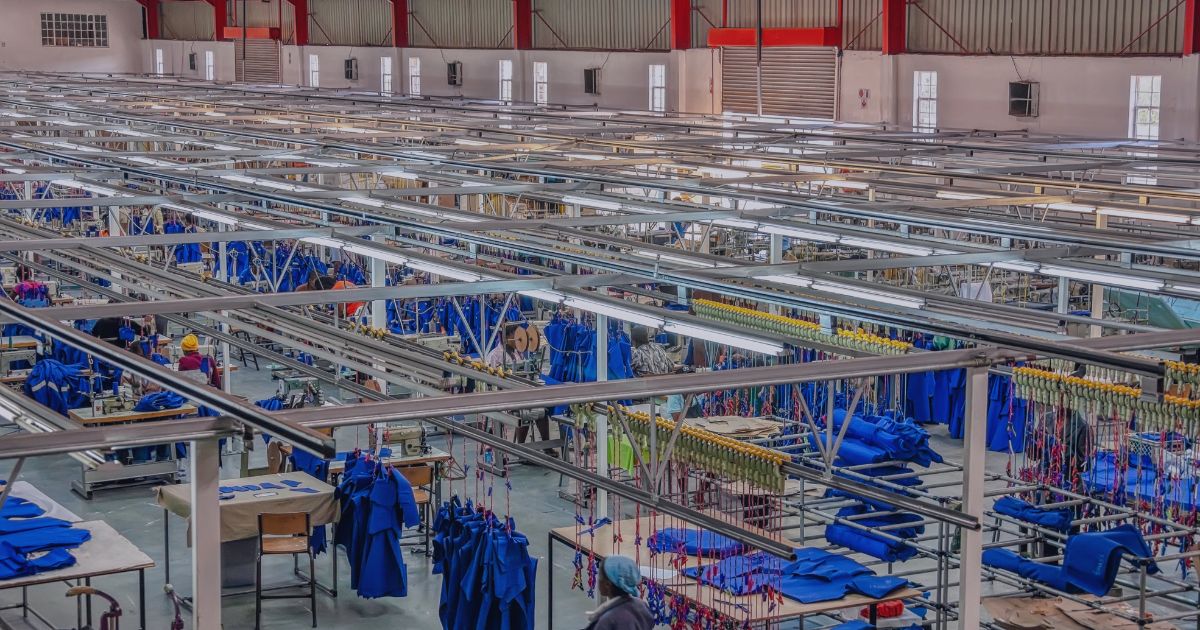Environmental activists have long espoused the benefits of local manufacturing industries and supply chains for reducing greenhouse gas emissions. Producing locally has a lower carbon footprint than producing across borders or overseas, as it generally requires fewer resources and involves shorter distances and less transportation. Additionally, strong local industries and markets result in economic resilience and flexibility, which makes nations better at responding effectively to unpredictable climate change-related events.
Beyond environmental advantages, thriving local industries strengthen local economies while reducing unemployment, improving the quality of work and quality of living, and boosting cultural identity. Manufacturing jobs created by local employers often translate to supply chains in which proximity and cultural resonance simplify management and communication. This leads to enhanced working conditions, higher standards and efficiency of manufacturing practices, faster delivery times, and the development of goods and services that are culturally appropriate and better at satisfying the needs of the local environment and communities. It also leads to more economic independence, something which is crucial in an interdependent globalized world, especially during times of geopolitical conflict or climate crisis.
In this article, we’ll explore the pros and cons of localized production and what impacts that can have on African nations.
International Trade for Growth and Economic Development
Recognizing the power of increased local development and economic independence is not equivalent to calling for an end to globalization, nor is it a failure to recognize the many benefits of cross-border supply chains and international trade. For over 250 years, since the advent of the First Industrial Revolution, nations worldwide have opted to engage in trade precisely because of the opportunities offered by increased access to economic resources such as land, labor, and capital. Still today, trade is recognized by economic advisors to the United Nations (UN) as “a powerful instrument to stimulate economic progress and alleviate poverty”; poor nations can join existing supply chains rather than having to invest decades in building their own.
Trade allows for economic specialization where nations have a comparative advantage, which leads to economic growth and increased access to a wider range of goods, services, know-how, and technology. This may create new opportunities for innovation and economic diversification at a local level. At an international level, global supply chains lead to economic interrelation, which may encourage more peaceful relations between nations.
The idea that international trade and strong local supply chains and markets go hand-in-hand is in line with ideas presented by Michael H. Shuman in his book Going Local, where he explains that local “does not mean walling off the outside world” (Robinson and Lamore 2010). Rather, “going local” means nurturing self-sufficiency and becoming less dependent on imports. This way, control and monetary gains flow back into communities and locally owned businesses, which “use local resources sustainably, employ local workers at decent wages and serve primarily local consumers” (Robinson and Lamore 2010).
Critiques of Globalization
Although the benefits of international trade and global supply chains are clear, their planetary cost has been scrutinized in the last decades. The type of large-scale industrialization that global trade allows depends on the highly contaminating extraction and burning of dwindling fossil fuel reserves, which the global scientific community has directly correlated to climate change.
Another major critique of international trade relates to the ways that it has worked to exacerbate economic inequalities between developed nations and developing countries, particularly since the advent of computerization in the 20th century. As communication technologies became more sophisticated and manufacturing more automized, relocating complex production processes from wealthier nations to poorer countries became possible. This allowed more developed nations like G7 countries to de-industrialize and move their factory workforces into offices while moving production facilities to countries like India and China to exploit the cheaper labor and more lax environmental regulations. Such trends explain why the US manufacturing job share fell from 30% in 1970 to 10% in 2010, while China’s “export-oriented” manufacturing industry, powered largely by burning coal, “spasmed.” Burning coal became one of the main contributors to local air pollution, which a 2015 study linked to 1.6 million deaths in China every year.

Lack of Economic Diversification in Africa
Yet another criticism of global supply chains is exemplified by most African nations, where industrial development and economic diversification have lagged behind, despite the opportunities afforded by a growing youthful population and an abundance of natural resources. According to the International Monetary Fund’s Export Diversification Index (2020), eight of the world’s fifteen least economically diversified countries are in Africa. To clarify, economic diversification implies “transitioning away from dependence on one or a few commodities such as crude oil, minerals, and agriculture production” toward “a broader range of sources of production, employment, trade, revenues, and expenditure.”
The reasons for the lack of diversification and related development are complex and specific to each African nation. However, in all cases, include a heavy reliance on foreign value-added products and a lack of incentives, investment, and policy frameworks to promote local industries and consumer markets. In 2017, 52% of African exports were raw materials, and the continent’s share of global merchandise exports barely changed between 1998 (1.9 percent) and 2018 (2.5 percent). Moreover, at 17%, Africa has relatively low intra-regional trade levels compared to Europe (69 percent), Asia (59 percent), or North America (31 percent). The EU is Africa’s largest trading partner. In 2021, 65 % of goods exported to the EU from Africa were primary goods (food and drink, raw materials, and energy), while 68 % of goods imported from the EU to Africa were manufactured goods.
Because diversification is important for growth and resilience, most African countries have long been considered vulnerable to external shocks, such as volatile changes in commodity prices. The risks of exaggerated far-flung foreign dependence have become most apparent over the last few years in the face of climate-related extreme weather events, the COVID pandemic, and Russia’s invasion of Ukraine. Such events have wreaked havoc on global supply chains, complicating imports and driving up prices for food and energy worldwide. The consequences have been particularly dramatic in Africa, which is currently experiencing a food crisis and food emergencies in the Democratic Republic of Congo, Northern Eastern Nigeria, Northern Mozambique, Sahel, Somalia, Sudan, and South Sudan.

Opportunities to Re-examine Current Production Methods
In a previous article, we explained how Africa’s current nutrition crisis could be avoided in the future if nations managed to move away from a food-import approach as a means to guarantee local food security and instead work towards food independence by turning some of the world’s most arable land into enough food to feed its growing nations. The article details ways to strengthen and improve existing domestic production and supply chains, for example, by taking advantage of collaborative networks and innovative technologies that could serve and empower the large Sub-Saharan subsistence farmers struggling to get their products to market. Furthermore, it discusses opportunities for intra-regional collaboration and cross-continental deals with partners in Asia and the Gulf region to gain access to funding and know-how while securing food for populations that inevitably need to outsource their production given a local lack of agricultural land and water resources. This framework and many of these suggestions may be useful beyond the agricultural industry for innovating and adding value to local production.
Another major and related opportunity in Africa involves fashion and the textile industry, particularly in Kenya and Nigeria. This suggestion may be met with a groan by those watching the Nigerian Textile Industry collapse after years of failure to attract investors.
According to the Nigerian Bureau of Statistics (NBS), imported fabrics and clothing materials were the number one imported product into the country in 2021 despite the Central Bank of Nigeria’s efforts to discourage its importation and motivate consumption of local products.
The suggestion to strengthen the domestic textile markets may also be met with skepticism by those following Kenya’s struggle to curb the growth of the Mitumba sector: the sale of cheap second-hand clothing imported from overseas, which employs roughly 2 million people. Kenya ranks among the largest importers of clothing in the region, which dresses 95% of the population. These numbers are significant but small compared to the value and jobs that could be added to the economy by a thriving formal local textile sector with fully integrated supply chains. Once known as leader in the textile industry, Nigeria and Kenya have been unsuccessful at lowering the prices of locally manufactured textile goods enough to compete with imported brands.
Still, there are many important reasons to suggest that recent development failures in Nigeria and Kenya are not a problem of potential but rather a lack of vision and lack of coordination policies that are worth restructuring. The first reason is the long history and remaining evidence of success in textile manufacturing in both countries. In addition to the type of infrastructure required for textile production —no small detail in a region where infrastructure is largely underdeveloped— raw materials for textiles, such as cotton and dyes, abound locally, as well as experience and technical know-how in textile manufacturing.
In 1997, Nigeria boasted the second-largest textile industry on the continent and was the largest employer of labor after the government. In Kenya, the cotton, textiles, and apparel (CTA) industry is the second biggest manufacturing activity. As one expert explains: “If you go the Export Processing Zone (EPZ)….you will find that the skills, the machinery, the competencies are actually in the country .”
The problems that need to be addressed for local textile industries to thrive in each country vary, but many of the solutions have already been demonstrated on the continent. Nigeria, for example, lacks a special manufacturing economic zone such as the textile industrial parks that have allowed countries like Ethiopia, Rwanda, and Kenya to concentrate energy resources, activity, and connectivity enough to boost textile production. Nigeria and Kenya lack incentives for cotton farmers to produce enough materials for the local industry rather than focus solely on exports. These incentives are key as up to 70 percent of the cost of making any piece of clothing is the fabric, so local inputs and greater coordination within the textile value chain could bring prices down significantly. There may also be a need to waive duties on the imported fabric while local textile mills expand and improve their offering.

A Vision for More Localized and Sustainable Production
As the world reorients its focus towards more sustainable fashion, innovations in artificial intelligence are changing how goods are manufactured, from mass-produced articles to small batches of unique tailored-made products. Governments and businesses across Africa are being called to recognize the possibilities afforded by The African Continental Free Trade Area (AfCFTA) and its ambition to create a continent-wide market embracing 55 countries with 1.3 billion people and a combined GDP of US$3.4 trillion.
As Africa’s young population grows, so will global and continental demand for clothing. There are incredible opportunities to use fashion to tell compelling stories about African identity. The vision and talent of Africa’s youthful entrepreneurial population, eager to embrace and communicate their African heritage, should not be overlooked. Such stories will be fundamental to promoting the type of unity and motivation required to achieve the workforce for local development of all kinds, as well as a local market and consumer base that values and has a taste for locally made African goods.




